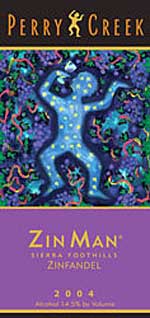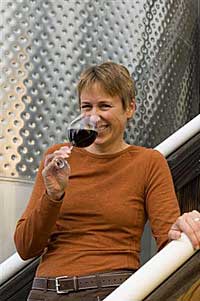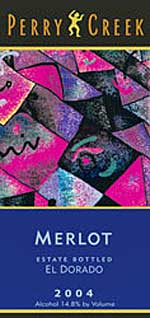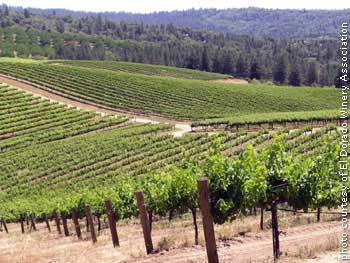

Perry Creek's popular ZinMan Zinfandel will remain at the top of the winery's roster as Rhone varietals get more emphasis.
Perry Creek Adjusts Focus:
New Owners Change Winery's Direction
I think you will see with the premium wines a slant toward producing more complex wines; wines with the fruit and flavors that we have always produced but with added dimension and structure.
~ Nancy Steel, Perry Creek winemaker
by
Jean Deitz Sexton
March 9, 2007
Jean Deitz Sexton (JDS): Since they already owned 29 acres of Fair Play vineyards, why did Wilms and Juergens choose to buy Perry Creek rather than build their own winery?
Nancy Steel (NS): Rather than start a winery in the region from the ground up, Michele and Dieter chose to purchase

Perry Creek’s winemaker,
Nancy Steel
Perry Creek because of its modern facilities and production capabilities. Perry Creek had good wines which they could expand upon, a winemaker that was established and a facility that suited their plans.
JDS: What can you tell us about plans for Perry Creek under the new owners?
NS: The new owners’ vision is to focus on distinctive varietals that reflect the region’s character and to identify Perry Creek as one of the premium wineries in the Sierra foothills. We will be focusing on high-end Syrah, Petite Sirah and Zinfandel, wines that we consider to be perfect matches with the region’s soils and microclimates. Our winemaking team feels these varietals will further define the appellation as well as the new direction of the winery.
JDS: How does this differ from the focus of Perry Creek in the past?
NS: The original 11 acres of Perry Creek vineyards were primarily planted with Viognier, Syrah and Merlot. We also have Marsanne and Rousanne. We will be embarking on a five-year replanting program.
JDS: How much will the existing Perry Creek vineyards change?
NS: The plan is still evolving. We may keep some Syrah and a bit of Merlot. Michele and Dieter do believe in Rhone varietals. More Viognier is a possibility and possibly some Grenache.
Michele and Dieter do believe in Rhone varietals. More Viognier is a possibility and possibly some Grenache.
JDS: Can you explain how you will integrate the new owners’ vineyards with your original Perry Creek vineyards?
NS: As plans evolve, we will be phasing in wines from Michele and Dieter’s vineyards and phasing out some of the Perry Creek wines. Michele and Dieter’s first commercial vintage is 2005. These wines were moved to Perry Creek for aging in November, 2005. Consumers will see a 2005 Zinfandel, Syrah, Petite Sirah, Cabernet, Chardonnay and a 2006 Viognier on the shelves and in restaurants, in 2007. The first wines will be released beginning in May with our Petite Sirah and Zinfandel from Fair Play Farms.
From the Perry Creek vineyard we have also bottled a Syrah and a Cellar Select Syrah, a Merlot and a Chardonnay to take us through the transition. We have released our 2005 Viognier.
JDS: What about ZinMan?
NS: Our popular ZinMan Zinfandel at $14 to $16 will continue. It’ s always been an upfront, drinkable, good value wine, not one to put down for 30 years.
JDS: Tell us more about this new focus on Syrah, Petite Sirah and Zinfandel.
NS: We are going to expand the top tier range with grapes sourced from Michele and Dieter’s Fair Play Farms vineyards. Previously, Perry Creek had a Cellar Select tier and that will be phased out and replaced with the new high end tier . However, the price range should stay pretty consistent, at about $26 to $28 a bottle.
JDS: Let’s explore the Fair Play appellation and how these grapes thrive in this particular climate.
NS: For all three varietals, the climate here is key to their success. The higher elevations bring greater temperature variations. Our best vineyards are situated on ridge tops to allow for excellent air drainage. The soils throughout our vineyards are composed of decomposed granite. These coarse sandy loams allow deep rooting depths and superior water drainage. Because of our higher elevations and mountain geography, we average 35-40 inches of rain per year.
JDS: Let’s talk about each of the three varietals, first Zinfandel.
NS: Zinfandel is an historic grape in this area, planted by early settlers, and has proven to produce unique and quality wines. Zinfandel in Fair Play is a classic. The higher elevations, the geography, the soils, and the weather patterns - these all combine to produce unique Zinfandel. Our signature Zin flavors are a dark, zippy fruit and an earthiness that adds character to the fruit flavors. Also, the good acids we get are an important component of our Zins.

Perry Creek’s vineyards in the Fair Play AVA of the Sierra Foothills.The ZinMan, made from El Dorado fruit, is classic Sierra Foothills combining all these elements and we blend in some Amador County Zin which contributes a peppery spice character with distinct briary notes.
JDS: Great, let’s explore Petite Sirah.
NS: Petite Sirah is a niche wine but currently growing in interest and stature. We feel we can produce some top quality Petite’s in our mountain climate and because Petite isn’t grown and produced in large quantities, we can gain recognition for Petite in the Fair Play area. However, Petite Sirah has turned out to be a tricky grape to work with. In our vineyards, it has turned out to be sensitive to dehydration and crop levels, more so than other varietals. On the cooler north slopes with slower ripening, it develops its characteristics and has a very appealing peppery spice.
JDS: And last, Syrah.
NS: I have produced Syrah for 14 years now at Perry Creek and have produced many well-received and award-winning Syrahs. Syrah grows well here and showcases its tremendous fruit, body and structure in this area. I have worked with 3 distinct blocks of Syrah at Perry Creek. These are grown within throwing distance of each other. And within the biggest block (5 acres) there are 3 distinct sections. For me, Syrah shows the most variability within a given area of any other variety I wor
Nancy Steel (NS): Rather than start a winery in the region from the ground up, Michele and Dieter chose to purchase

Perry Creek’s winemaker,
Nancy Steel
JDS: What can you tell us about plans for Perry Creek under the new owners?
NS: The new owners’ vision is to focus on distinctive varietals that reflect the region’s character and to identify Perry Creek as one of the premium wineries in the Sierra foothills. We will be focusing on high-end Syrah, Petite Sirah and Zinfandel, wines that we consider to be perfect matches with the region’s soils and microclimates. Our winemaking team feels these varietals will further define the appellation as well as the new direction of the winery.
JDS: How does this differ from the focus of Perry Creek in the past?
NS: The original 11 acres of Perry Creek vineyards were primarily planted with Viognier, Syrah and Merlot. We also have Marsanne and Rousanne. We will be embarking on a five-year replanting program.
JDS: How much will the existing Perry Creek vineyards change?
NS: The plan is still evolving. We may keep some Syrah and a bit of Merlot.
 Michele and Dieter do believe in Rhone varietals. More Viognier is a possibility and possibly some Grenache.
Michele and Dieter do believe in Rhone varietals. More Viognier is a possibility and possibly some Grenache.
JDS: Can you explain how you will integrate the new owners’ vineyards with your original Perry Creek vineyards?
NS: As plans evolve, we will be phasing in wines from Michele and Dieter’s vineyards and phasing out some of the Perry Creek wines. Michele and Dieter’s first commercial vintage is 2005. These wines were moved to Perry Creek for aging in November, 2005. Consumers will see a 2005 Zinfandel, Syrah, Petite Sirah, Cabernet, Chardonnay and a 2006 Viognier on the shelves and in restaurants, in 2007. The first wines will be released beginning in May with our Petite Sirah and Zinfandel from Fair Play Farms.
From the Perry Creek vineyard we have also bottled a Syrah and a Cellar Select Syrah, a Merlot and a Chardonnay to take us through the transition. We have released our 2005 Viognier.
JDS: What about ZinMan?
NS: Our popular ZinMan Zinfandel at $14 to $16 will continue. It’ s always been an upfront, drinkable, good value wine, not one to put down for 30 years.
JDS: Tell us more about this new focus on Syrah, Petite Sirah and Zinfandel.
NS: We are going to expand the top tier range with grapes sourced from Michele and Dieter’s Fair Play Farms vineyards. Previously, Perry Creek had a Cellar Select tier and that will be phased out and replaced with the new high end tier . However, the price range should stay pretty consistent, at about $26 to $28 a bottle.
JDS: Let’s explore the Fair Play appellation and how these grapes thrive in this particular climate.
NS: For all three varietals, the climate here is key to their success. The higher elevations bring greater temperature variations. Our best vineyards are situated on ridge tops to allow for excellent air drainage. The soils throughout our vineyards are composed of decomposed granite. These coarse sandy loams allow deep rooting depths and superior water drainage. Because of our higher elevations and mountain geography, we average 35-40 inches of rain per year.
JDS: Let’s talk about each of the three varietals, first Zinfandel.
NS: Zinfandel is an historic grape in this area, planted by early settlers, and has proven to produce unique and quality wines. Zinfandel in Fair Play is a classic. The higher elevations, the geography, the soils, and the weather patterns - these all combine to produce unique Zinfandel. Our signature Zin flavors are a dark, zippy fruit and an earthiness that adds character to the fruit flavors. Also, the good acids we get are an important component of our Zins.

Perry Creek’s vineyards in the Fair Play AVA of the Sierra Foothills.
JDS: Great, let’s explore Petite Sirah.
NS: Petite Sirah is a niche wine but currently growing in interest and stature. We feel we can produce some top quality Petite’s in our mountain climate and because Petite isn’t grown and produced in large quantities, we can gain recognition for Petite in the Fair Play area. However, Petite Sirah has turned out to be a tricky grape to work with. In our vineyards, it has turned out to be sensitive to dehydration and crop levels, more so than other varietals. On the cooler north slopes with slower ripening, it develops its characteristics and has a very appealing peppery spice.
JDS: And last, Syrah.
NS: I have produced Syrah for 14 years now at Perry Creek and have produced many well-received and award-winning Syrahs. Syrah grows well here and showcases its tremendous fruit, body and structure in this area. I have worked with 3 distinct blocks of Syrah at Perry Creek. These are grown within throwing distance of each other. And within the biggest block (5 acres) there are 3 distinct sections. For me, Syrah shows the most variability within a given area of any other variety I wor










 READER FEEDBACK: To post your comments on this story,
READER FEEDBACK: To post your comments on this story,




